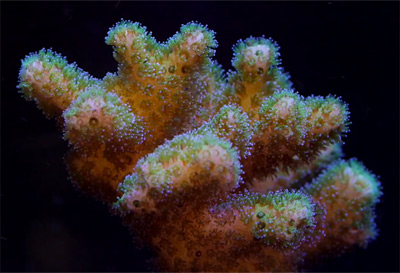You may not be aware, butPocillopora中,尽管阿宝越少pular stony corals in the reef aquarium hobby, are second only toAcroporain reef-building productivity in the wild. Their skeletons make up a huge portion of the reef’s structure in the ocean.Pocilloporaare also among the most adaptableSPS coralsin that they tolerate a wide range of bothlightand flow.
At Tidal Gardens, we grow them under medium light and medium flow, but they do develop better coloration under stronger light. If you want to experiment with stronger light, be sure to acclimate the coral slowly to the light because it is possible to burn them if done too hastily.
The other aspect that makesPocilloporahighly effective reef-building corals is their growth rate. They are among the fastest-growing stony corals and have a trick up their sleeve if things go downhill—they can reproduce asexually by means of “polyp bailout,” where each polyp can detach from its skeleton and drift to a new location to colonize. While this technique is not unique toPocillopora, these corals do it far more effectively than others.

Usually polyp bailout is employed as a last-ditch effort in response to something going wrong. Other stony corals such aselegancesandbubble coralsbail out, but most of the time those corals do not survive.Pocillopora, on the other hand, can spread all over the tank and wind up recolonizing in unexpected crevices.

As for feeding,Pocilloporado not appear to need it as much as other corals. These corals are photosynthetic and get most of their nutrition from light; however, it is possible to feed them provided the food is fine enough for their small polyps to consume. When attempting to feed, start with the cloudy supernate you get from thawing frozen food or possibly one of the powdered zooplankton foods. Remember, though, to not overdo these fine foods because the risk of exceeding the tank’s filtration capacity is far worse than not feeding at all.
Lastly, these corals tend to be very hardy, but if you happen to see mysterious die off occur, consider giving it a dip in a pest-control solution. There are some crustaceans that eatPocillopora, so it is important to keep a watchful eye on the base of the coral for any signs of recession. The bugs look like big, white fleas and will jump off quickly when dipped.


